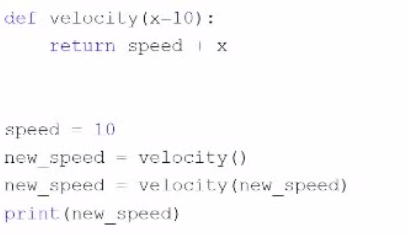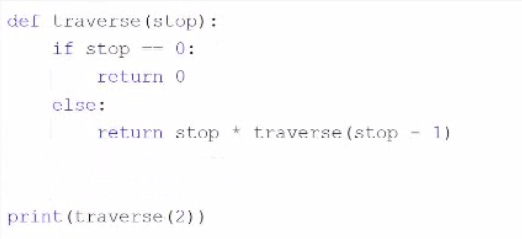Master Python Institute PCEP-30-02 Exam with Reliable Practice Questions
What is true about exceptions and debugging? (Select two answers.)
Correct : A, C
Exceptions and debugging are two important concepts in Python programming that are related to handling and preventing errors. Exceptions are errors that occur when the code cannot be executed properly, such as syntax errors, type errors, index errors, etc. Debugging is the process of finding and fixing errors in the code, using various tools and techniques. Some of the facts about exceptions and debugging are:
One try-except block may contain more than one except branch. A try-except block is a way of handling exceptions in Python, by using the keywords try and except. The try block contains the code that may raise an exception, and the except block contains the code that will execute if an exception occurs. You can have multiple except blocks for different types of exceptions, or for different actions to take. For example, you can write a try-except block like this:
try: # some code that may raise an exception except ValueError: # handle the ValueError exception except ZeroDivisionError: # handle the ZeroDivisionError exception except: # handle any other exception
The default (anonymous) except branch can be the last branch in the try-except block. The default except branch is the one that does not specify any exception type, and it will catch any exception that is not handled by the previous except branches. The default except branch can be the last branch in the try-except block, but it cannot be the first or the only branch. For example, you can write a try-except block like this:
try: # some code that may raise an exception except ValueError: # handle the ValueError exception except: # handle any other exception
This is a valid try-except block, and the default except branch will be the last branch. However, you cannot write a try-except block like this:
try: # some code that may raise an exception except: # handle any exception
Therefore, the correct answers are A. A tool that allows you to precisely trace program execution is called a debugger. and C. One try-except block may contain more than one except branch.
Start a Discussions
Which of the following functions can be invoked with two arguments?
A)

B)

C)

D)

Correct : B
The code snippets that you have sent are defining four different functions in Python. A function is a block of code that performs a specific task and can be reused in the program. A function can take zero or more arguments, which are values that are passed to the function when it is called. A function can also return a value or None, which is the default return value in Python.
To define a function in Python, you use the def keyword, followed by the name of the function and parentheses. Inside the parentheses, you can specify the names of the parameters that the function will accept. After the parentheses, you use a colon and then indent the code block that contains the statements of the function. For example:
def function_name(parameter1, parameter2): # statements of the function return value
To call a function in Python, you use the name of the function followed by parentheses. Inside the parentheses, you can pass the values for the arguments that the function expects. The number and order of the arguments must match the number and order of the parameters in the function definition, unless you use keyword arguments or default values. For example:
function_name(argument1, argument2)
The code snippets that you have sent are as follows:
A) def my_function(): print(''Hello'')
B) def my_function(a, b): return a + b
C) def my_function(a, b, c): return a * b * c
D) def my_function(a, b=0): return a - b
The question is asking which of these functions can be invoked with two arguments. This means that the function must have two parameters in its definition, or one parameter with a default value and one without. The default value is a value that is assigned to a parameter if no argument is given for it when the function is called. For example, in option D, the parameter b has a default value of 0, so the function can be called with one or two arguments.
The only option that meets this criterion is option B. The function in option B has two parameters, a and b, and returns the sum of them. This function can be invoked with two arguments, such as my_function(2, 3), which will return 5.
The other options cannot be invoked with two arguments. Option A has no parameters, so it can only be called with no arguments, such as my_function(), which will print ''Hello''. Option C has three parameters, a, b, and c, and returns the product of them. This function can only be called with three arguments, such as my_function(2, 3, 4), which will return 24. Option D has one parameter with a default value, b, and one without, a, and returns the difference of them. This function can be called with one or two arguments, such as my_function(2) or my_function(2, 3), which will return 2 or -1, respectively.
Therefore, the correct answer is B. Option B.
Start a Discussions
Which of the following are the names of Python passing argument styles?
(Select two answers.)
Correct : A, D
Start a Discussions
What is the expected result of the following code?

Correct : A
The code snippet that you have sent is trying to use the global keyword to access and modify a global variable inside a function. The code is as follows:
speed = 10 def velocity(): global speed speed = speed + 10 return speed
print(velocity())
The code starts with creating a global variable called ''speed'' and assigning it the value 10. A global variable is a variable that is defined outside any function and can be accessed by any part of the code. Then, the code defines a function called ''velocity'' that takes no parameters and returns the value of ''speed'' after adding 10 to it. Inside the function, the code uses the global keyword to declare that it wants to use the global variable ''speed'', not a local one. A local variable is a variable that is defined inside a function and can only be accessed by that function. The global keyword allows the function to modify the global variable, not just read it. Then, the code adds 10 to the value of ''speed'' and returns it. Finally, the code calls the function ''velocity'' and prints the result.
However, the code has a problem. The problem is that the code uses the global keyword inside the function, but not outside. The global keyword is only needed when you want to modify a global variable inside a function, not when you want to create or access it outside a function. If you use the global keyword outside a function, you will get a SyntaxError exception, which is an error that occurs when the code does not follow the rules of the Python language. The code does not handle the exception, and therefore it will terminate with an error message.
The expected result of the code is an unhandled exception, because the code uses the global keyword incorrectly. Therefore, the correct answer is A. The code is erroneous and cannot be run.
The code is erroneous because it is trying to call the ''velocity'' function without passing any parameter, which will raise aTypeErrorexception. The ''velocity'' function requires one parameter ''x'', which is used to calculate the return value of ''speed'' multiplied by ''x''. If no parameter is passed, the function will not know what value to use for ''x''.
The code is also erroneous because it is trying to use the ''new_speed'' variable before it is defined. The ''new_speed'' variable is assigned the value of 20 after the first function call, but it is used as a parameter for the second function call, which will raise aNameErrorexception. The variable should be defined before it is used in any expression or function call.
Therefore, the code will not run and will not produce any output.
The correct way to write the code would be:
# Define the speed variable
speed = 10
# Define the velocity function
def velocity(x):
return speed * x
# Define the new_speed variable
new_speed = 20
# Call the velocity function with new_speed as a parameter
print(velocity(new_speed))
Copy
This code will print 200, which is the result of 10 multiplied by 20.
[Python Programmer Certification (PCPP) -- Level 1]
[Python Programmer Certification (PCPP) -- Level 2]
[Python Programmer Certification (PCPP) -- Level 3]
[Python: Built-in Exceptions]
[Python: Defining Functions]
[Python: More on Variables and Printing]
Start a Discussions
What is the expected output of the following code?

Correct : D
The code snippet that you have sent is using the count method to count the number of occurrences of a value in a list. The code is as follows:
my_list = [1, 2, 3, 4, 5] print(my_list.count(1))
The code starts with creating a list called ''my_list'' that contains the numbers 1, 2, 3, 4, and 5. Then, it uses the print function to display the result of calling the count method on the list with the argument 1. The count method is used to return the number of times a value appears in a list. For example, my_list.count(1) returns 1, because 1 appears once in the list.
The expected output of the code is 1, because the code prints the number of occurrences of 1 in the list. Therefore, the correct answer is D. 1.
Start a Discussions